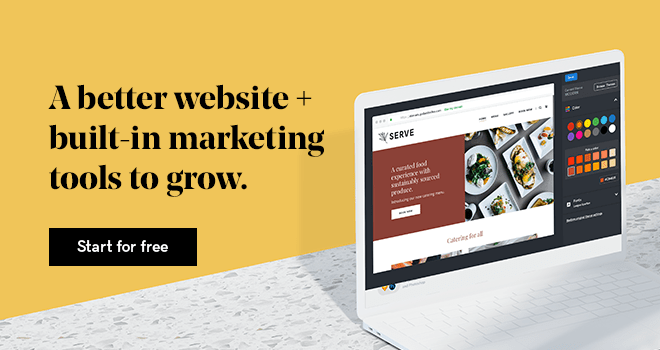Knowing how to price products might seem simple, like just another task to accomplish for a business owner in the development phase.
However, pricing a product is more than slapping on a price tag or typing an amount into your ecommerce platform. It’s a complex process that affects the overall success and profitability of your ecommerce business.
According to eMarketer data, U.S. ecommerce sales grew by 8.7% in 2024 to nearly $1.2 trillion, comprising 16.2% of total retail sales.
That jump in ecommerce traffic means there's now stiff competition for new and established ecommerce businesses alike.
Beyond creating and marketing a unique product, pricing will play a critical role in customer perception. Scientific studies show consumers equate price with product quality.
Related: How to start an online store
Establishing a competitive pricing strategy for your ecommerce business
As an entrepreneur, you need to determine an appropriate price that your target customer is willing to pay, matches the competition, and still yields a healthy profit. Let’s take a look at that.
1. Know your local competition
Whether you’re a new business pricing products for the first time or an established business reassessing your pricing strategy, competitor research is invaluable.
It may seem counterintuitive, but understanding your local competition is also important.
While an online store has a global audience, consider that people in your local area can look elsewhere in the community or might have personal ties to smaller, locally-owned brick-and-mortar businesses.
Additionally, when developing your pricing strategy, understand the relationship between online and in-store pricing and shopping.
Today’s savvy consumer knows that ecommerce removes many of the hard costs of getting products to market, so they expect to see lower prices online. Take this into account when you research local brick-and-mortar competition.
2. Understand the online market

Just like knowing your local competition, being aware of your digital competition is essential, especially in this increasingly competitive ecommerce field. Conduct quick, informal competitor research of similar products.
Start a list or spreadsheet with your competitors’ price points. Make sure to note product differentiators in relation to their pricing.
What makes your competition stand out? What explanations do they give regarding their quality or unique characteristics that account for their prices?
Alternatively, if you find bargain or discounted pricing amongst the competition, why might that be? Look at consumer reviews for real feedback to see if any mention price versus value of the product.
Once you’ve accumulated a range of price points and competitor data, think about your product and your unique selling points (USP), and apply that to your pricing strategy.
Do you want to be a value player or a low-cost leader? Can you command a higher price than your competition because of brand quality or features?
Keep in mind that it’s challenging to convert shoppers into buyers. As of the third quarter of 2020, the average online conversion rate hovered between 1.68% and 3.62% (depending on the device), according to data from Kibo Commerce.
In the saturated world of ecommerce, where competition is fierce, knowing how to price products in relation to the online market will increase sales and maximize profit.
Remember, your goal should be to model your competitors, not to copy them. Use their pricing strategies as inspiration and then develop your own unique, product- and customer-based pricing models.
3. Assess all of your costs
When evaluating potential pricing structures for your ecommerce products, it's essential to have a solid grasp on all costs associated with your business so that you can ensure healthy and sustainable profits.
Fixed costs
These represent your hard costs that are unchanging; for example, the cost of hosting your ecommerce site, meeting payroll for any employees, leasing space for on-premise storage or offices, and marketing. These are costs that do not fluctuate based on an increase in sales or production.
Variable costs
These are costs that change based on production or sales volume. For example, your production costs might increase if you need more products, or perhaps the cost of materials lowers as you order more.
Gathering all of your data related to costs is an essential step in pricing your products.
Make sure to take your time. It’s easy to miss expenses, such as services you pay for annually or quarterly. Once you understand your fixed and variable costs, you can perform a break-even analysis using a break-even analysis spreadsheet.
Picture 1, Picture
This will help you determine the number of units you need to sell to cover all your costs. You can also learn more about writing a business sales plan to speed up your process.
Using a product pricing calculator
A product pricing calculator can help you find a profitable selling price, which can be incredibly helpful for seeing how different price points may affect your business.
By leveraging these pricing tools and automation software, you can automate competitor price tracking, facilitate strategic pricing decisions, and effectively monitor and adjust your prices to stay competitive in the market.
Bottom line: You need to understand what it’s costing you to produce products and run your business, so you can accurately price products to sustain and maximize profits.
4. Determine your profit margin

Profit margin is the percentage of revenue you make on each unit after you deduct your fixed and variable costs per product. For example, if you set the retail price of your product at $80 and it costs you $60 to make, then your profit is $20, which represents a 25% profit margin.
Average healthy profit margins tend to vary by industry. For example, in clothing, it ranges from 4% to 13%, based on recent data.
To determine a realistic profit margin, first, do a quick break-even analysis. This is where you determine the number of sales you need to at least cover your costs. Consider your fixed costs for the business and the variable costs per product.
From there, you can adjust your pricing strategy accordingly to determine a competitive yet optimized profit margin.
Your pricing directly determines your profit margin, and this is where you’ll have to factor in all of your research and knowledge. There’s no sense in undercutting your competitors’ pricing if you can’t make a return on your investment or even worse, turn any profit.
5. A/B test your pricing strategy
If you want to try out a few different pricing strategies, test them against one another in real time. A/B testing, also known as split testing, usually occurs in web design or digital marketing.
But you can also use this tactic to help determine competitive pricing strategies for ecommerce. Simply use different pricing structures at the same time on your website and see which yields the best results or most sales.
You can A/B test your pricing strategies in two ways:
Digital marketing campaigns
If you have any type of digital marketing campaigns that funnel traffic to your product landing pages, like PPC, social media ads, or email marketing, create two landing pages with different pricing and equally direct traffic to each.
After a set amount of time, see which product has the best conversion rate.
Different products
If you have different products of a similar nature and price point, you can test pricing strategies on each. Then track sales and see if one outperforms the others.
Emphasizing real customer feedback is crucial during this testing phase. Launch your products and gather authentic feedback from your customers to inform your pricing decisions effectively.
This real-world data is invaluable in understanding what your customers truly value and are willing to pay for your products.
Stuck on which type of pricing strategies to test? QuickBooks recommends these standard pricing models:
Pricing at a Premium:
Price products higher than your competition, then market the value perception and unique features that constitute the premium price.
Penetration pricing
Generally used for new businesses or products that can afford to offer a lower price tag to steal attention from competitors. You can label this as a low introductory deal that will increase as time goes on.
Economy pricing:
Often difficult for smaller ecommerce businesses, this is basically setting prices low to attract the budget-conscious shopper.
Price skimming
For new, unique products you set prices higher initially. As other competitors enter the market or interest wanes, prices gradually decrease—the opposite of the penetration method.
Psychology pricing
Appealing to the emotion of a shopper by setting illusions of lower prices and better deals. For example, pricing at $99 instead of $100 because customers might have a hard time spending past a certain threshold.
Bundle pricing
Offering lower pricing or a deal when a customer purchases multiple products—a type of bulk discount. Bundling works well if you have complementary products to pair together, want to move a specific low-selling product, or your variable costs decrease if you produce more items.
Cost-plus pricing
This strategy involves adding a fixed percentage or amount to the cost of producing your product to ensure a consistent profit margin. By calculating all variable and fixed costs, you can set a price that covers expenses and includes desired profits.
Value-based pricing
With value-based pricing, you price your products based on the perceived value to the customer rather than solely on cost. This approach considers how much your customers believe your product is worth and adjusts pricing to reflect that value.
Dynamic pricing
Dynamic pricing involves adjusting prices in real time based on market demand, competition, and other external factors. This method allows businesses to optimize prices for maximum profitability by responding quickly to changes in the market.
Depending on your industry, select pricing structures for your products and test a few against each other on your ecommerce site. Then make a data-driven choice, based on sales, to determine the best pricing strategy for your business.
6. Recognize the perils of underpricing

Something that may seem so simple, like how to price a product, is a foundational ingredient to your overall business health and viability. It’s essential to exercise caution when trying strategies like penetration or economy pricing because, in reality, you might be underpricing.
While it might be attractive to get the sales up front, underpricing can be dangerous to your ROI and bottom line.
Something else to consider: When you price products at the lowest possible point, not only are you diminishing your profit margin, but you also limit the possibility for adjustments. What if you want to run a sale or offer a discount?
If you lowball your product, there’s no wiggle room. Moreover, if you have a bargain basement perception, you won’t attract customers that value quality over cost.
Recent data from the NRF shows that 32% of shoppers rank "highest quality item" as their most important purchasing factor (more than the 30% that say price matters most).
Online consumers are savvy digital natives who understand you get what you pay for.
Underpricing affects more than just your profit.
Nellie Akalp, entrepreneur and founder of CorpNet.com, has cautioned that "even though you might land the sale, underpricing your products and services comes at a cost.
Entrepreneurship is challenging enough without feeling like you’re underpaid and overworked. Charging too little can not only put a damper on your revenue potential, but it can also douse your enthusiasm for your business."
7. Consistently review pricing strategies
You can’t have a set-it-and-forget-it attitude when it comes to pricing products, especially in the constantly evolving world of ecommerce. Business owners and entrepreneurs must consistently assess their data, metrics, and pricing strategies to ensure optimal sales and profit.
Moving forward, you need to consider cash flow, sales history, and changes in the customer market.
Aim to review and update pricing strategies at scheduled times, like once per quarter. You won’t always need to adjust prices each quarter but rather when necessary.
Alternatively, you may need to check prices more often depending on industry trends. Refer to this checklist of events that should trigger reviews and/or changes in pricing structures:
Cost changes
Your costs change, such as due to a minimum wage increase, changes in the cost of goods, or new tariffs introduced.
Economic shifts
The economy shifts, such as inflation, recession, or a global pandemic. Anything can happen, and, even though we think it won’t happen to us, it’s best to be prepared.
Competitor price changes
You notice that competitors change their prices. Check often, as they might be doing tests and change back to their initial price; you wouldn’t want to stay too cheap for too long.
New product launches
You launch a new product. If it’s a new version of an old product, you might be able to reduce the old version to get rid of any unwanted stock.
Market expansion
You enter a new market or vertical. If it’s an international expansion, you need to take into account any new taxes or shipping costs. This also applies when you want to increase your market share in your current market, pricing is a sensitive item for customers, it can help you gain more customers initially, but it’s not a long-term strategy; you can’t drop your prices constantly and keep a viable business.
High-performing products
You have a high-performing product, for example, you’re regularly sold out, or you receive a celebrity or influencer endorsement.
If any of the above occurs, use it as an alarm to stop and evaluate your pricing strategies to ensure they’re still effective.
Implementing price matching policies and the loss leader strategy
To stay competitive without constantly adjusting internal prices, consider implementing price matching policies and the loss leader strategy.
Price matching policies
Price matching allows you to offer customers the assurance that they’re getting the best possible deal.
By committing to match or beat competitors’ prices on similar products, you can build trust and encourage purchases without the need to frequently lower your prices across the board.
This strategy leverages real-time market data to maintain competitive pricing while preserving your overall profit margins.
Loss leader strategy
The loss leader strategy involves selling select products at a loss to attract customers to your store. These attractively priced items draw in shoppers who may then purchase additional products with higher margins.
This approach helps increase overall sales volume and customer traffic without the necessity of adjusting the prices of your entire product range.
By carefully selecting which products to offer as loss leaders, you can effectively balance attracting customers with maintaining profitability.
Implementing these strategies allows you to stay competitive in the market, attract a steady stream of customers, and optimize your pricing approach without the stress of constantly changing prices.
How to price products to maximize sales and profit
Pricing products is not an exact science, and it’s not an art form—it’s a dynamic, business-dependent strategy that can be challenging for even seasoned entrepreneurs, but a strategy that is absolutely essential for any profitable business idea.
With the boom in ecommerce due to pandemic-related changes also comes an increase in competition, as well as even savvier digital shoppers. Your decisions will depend on your particular niche, goals, products, industry, and other factors.
Know that you’ll need to put in the time to research your market and competition.
Crunch numbers on your costs to determine pricing that can maintain long-term product profitability. Analyze current business metrics and A/B test strategies to gather more data to bolster your decision-making.
Be cautious of underpricing. Finally, once you set your prices, know that it’s a living, breathing process that needs to be monitored and nurtured as your business and the market evolves.
Use GoDaddy Online Store to set up your storefront and start selling. With dedicated product pages, you can change the price as you work through your strategy.









